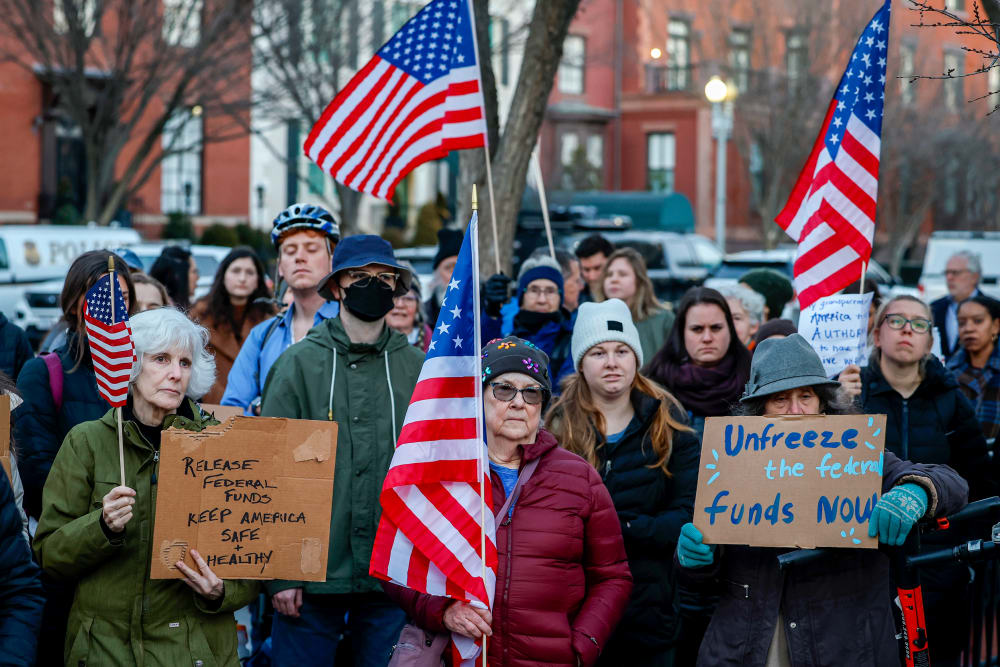For all the media coverage surrounding this week’s federal funding freeze — the confusion it created and the Trump administration’s abrupt decision to rescind the order — one critical narrative remains overlooked: the devastating economic impact a sweeping funding freeze would have on women.

And that reality hasn’t gone away. On Wednesday, White House Press Secretary Karoline Leavitt made it clear that while the broad OMB memo was pulled back, the administration’s efforts to review and cut federal spending would “remain in full force and effect, and will be rigorously implemented.”
This omission isn’t just an oversight — it’s a failure to recognize a predictable and deeply concerning pattern. Women, especially breadwinner moms, will bear the brunt of these cuts. In other words, President Trump’s funding freeze is not only unconstitutional — it’s a direct economic attack on women and children.
Women shoulder the burden — again
Women disproportionately suffer during fiscal austerity, a reality baked into our current system. Consider this: women are 35 percent more likely than men to live in poverty. The gender pay gap exacerbates this reality. Breadwinner moms, who support millions of children, earn just 66 cents for every dollar earned by breadwinner dads. When economic policies fail to account for these disparities, the damage compounds.
Everyone pays the ‘pink tax’ — whether you know it or not
Despite being the financial backbone of many households, public policy continues to be gender-ignorant — meaning it does not apply a gender lens to assess how policies impact men and women differently. This isn’t just an issue of fairness; it’s an economic constraint. When policies ignore 51 percent of the population, they constrict the economy as a whole.
The stakes for breadwinner moms
In my home state of Colorado, 45.2 percent of households with children depend on a breadwinning mother for financial security. Nationally, that figure is 40 percent%. In total, 16 million breadwinner moms in the U.S. support 28 million children. Yet these women remain financially disadvantaged due to systemic inequities. The federal funding freeze only exacerbates their vulnerability.
Children living with solo mothers are five times more likely to experience poverty than those living with solo fathers. This is not a coincidence — it’s the product of longstanding economic policies that ignore the realities of women’s labor and earnings. The funding freeze, which disproportionately impacts social safety net programs, will only drive more of female-headed families deeper into financial distress.
Women’s earnings are essential, not extra
Let’s dispel an outdated myth: women’s incomes do not bankroll an imaginary “purses and shoes” fund. Women are more likely to work in low-wage jobs — 69 percent of workers at or below minimum wage are female. When a woman loses her paycheck, she doesn’t cut back on luxury spending; she cuts back on housing, food, healthcare and childcare.

Today, 40 percent of U.S. households with children depend on a breadwinner mom to put food on the table. Without a steady, reliable income, these women are forced to make severe cuts that affect not just their families but the broader economy. On the macroeconomic level, this means a significant drop in demand — an issue policymakers would do well to anticipate.
Gender budgeting is a solution
We need a paradigm shift in how we approach government spending. Policymakers must adopt gender budgeting — a practice that assesses how financial decisions impact men and women differently. Instead of assuming government budgets are gender-neutral, we must acknowledge that men and women have distinct economic realities and lived experiences.
The necessity of gender budgeting is not a theoretical exercise — it’s an economic imperative. Women and children comprise 70 percent of America’s poor, and women are twice as likely as men to live in poverty during retirement. In 2020, 15.5 million children lived with solo moms, while only 3.3 million lived with solo dads. Of all female-headed households, 32 percent live in poverty — almost three times the rate of male-headed households and nearly seven times the rate of married-couple households.












